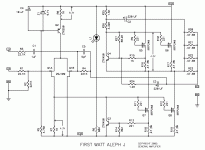Does it really make such an hearable difference?
Is better damping factor the only advantage or is there more advantages? Say you use a large inductor in the crossover with series resistance of 100 mOhms. Then damping factor is still 80 % of original with this amp which shouldn't affect it that much or?
Or just if for the sake of it you DIY wind an monster inductor with a series resistance of less than 50 mOhms so that damping factor is 90 % of original value. The Aleph J already have fairly low damping factor, does a decrease of 10-20 % really make such a difference?
I mean, DIY winding of obscene inductors would be way way cheaper and much more simple than building another Class A amp, matching levels and that
If one had an obscene inductor in the crossover with this amp, would biamp-improvements be theoretical or real? Are the tweeters affected negatively by the crossover or is it only the bass that suffers from less damping factor?
// Olle
Is better damping factor the only advantage or is there more advantages? Say you use a large inductor in the crossover with series resistance of 100 mOhms. Then damping factor is still 80 % of original with this amp which shouldn't affect it that much or?
Or just if for the sake of it you DIY wind an monster inductor with a series resistance of less than 50 mOhms so that damping factor is 90 % of original value. The Aleph J already have fairly low damping factor, does a decrease of 10-20 % really make such a difference?
I mean, DIY winding of obscene inductors would be way way cheaper and much more simple than building another Class A amp, matching levels and that
If one had an obscene inductor in the crossover with this amp, would biamp-improvements be theoretical or real? Are the tweeters affected negatively by the crossover or is it only the bass that suffers from less damping factor?
// Olle
Since it became a Xover-question i created a topic in multi way to continue that discussion there:
http://www.diyaudio.com/forums/multi-way/185809-biamp-tweeter-no-xover-main-driver.html#post2516749
http://www.diyaudio.com/forums/multi-way/185809-biamp-tweeter-no-xover-main-driver.html#post2516749
Driving a sub crossed at 40hz with an Aleph J really makes no logical sense. It was not designed for that. The typical subwoofer has distortion of several percent in that range, current and damping factor are much more important than the vanishing distortion numbers of a particular amp. An active low pass filter is the most logical way to do it.
Pretty much OT, hey.
Pretty much OT, hey.
I have desided to make 3 stereo Aleph J's instead of JX, to run some horns.
I remoddeled some big *** toroids to give 2x18 volts last night and need to order the PSU parts for CRC PSU, can someone help me with this. I am still learning how to do the PSU simulation and want to get a parts order off so i can receive the parts before Easter holidays. I think the toroids should be around 500va and I am using 4 output fets per board, going for 25 watts per channel.
Thanks in advance.
I remoddeled some big *** toroids to give 2x18 volts last night and need to order the PSU parts for CRC PSU, can someone help me with this. I am still learning how to do the PSU simulation and want to get a parts order off so i can receive the parts before Easter holidays. I think the toroids should be around 500va and I am using 4 output fets per board, going for 25 watts per channel.
Thanks in advance.
Hi
I would like to build an Aleph J. Can anyone help with schematics (original pass version) and/ or PCB's?
I have very efficient speakers ( >100db) and I do not many watts. What would be the minimun voltage rails that I can use?
Thanks
Roberto
Look at the first post of this very thread....
Look at the first post of this very thread....
And there is a corrected version here
http://www.diyaudio.com/forums/pass-labs/111197-aleph-j-schematic-7.html#post1343785
And there is a corrected version here
http://www.diyaudio.com/forums/pass-labs/111197-aleph-j-schematic-7.html#post1343785
Thank you!
Thanks a lot Nelson!
shopping for heatsinks I have found this
TRE S SRL - heat sink with fixing clip system - series screwless
what do you think about it??
shopping for heatsinks I have found this
TRE S SRL - heat sink with fixing clip system - series screwless
what do you think about it??
- Home
- Amplifiers
- Pass Labs
- Aleph J Schematic
